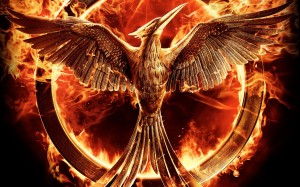I suppose I got a sense of it when I first read the books by Suzanne Collins, but watching The Hunger Games: Mockingjay – Part 1 really brought the message home: Mockingjay is mocking us. Not in a bad way, but in the way that makes us realize that dystopias aren’t just scenarios of a future gone sour but that both ojur past and our present may actually be considered already dystopic.
Without giving too much away (I hope), the thing that stands out most about this movie is that its themes draw heavily from the real-life history of this world. The use of mass media as a propaganda tool for instance might seem like a particularly cynical move to millenials weaned on a diet of vapid and politically correct media. Older generations however, will be unable to ignore the way every major conflict from the 20th century onward has been “sold,” to the timid and unconvinced, using news reels and capitalizing on cinematic tropes favored by the combatants: The hero emerging defiantly from the rubble; the villains rendered faceless so that the audiences are unable to humanize them and perhaps be tempted to sympathize with them; the oppressed lying broken and bloody in the dirt.
In some of its most effective scenes, Mockingjay went even further by showcasing some incredibly resonant images practically torn from the history of the world: Israelis singing Jerusalem of Gold while marching on Jerusalem during the 6 Day War; the 1930 march on the Dharasana salt works, in Gujarat, India, and an embattled British nation huddled in the dark while London was being bombed during the 2nd World War.
Of course, the movie was more than just a history lesson in disguise. So much so that even if the viewer were totally clueless (which, if you’ve gotten this far, you are hopefully not) about Mockingjay’s real world resonances, it’d still be a solid piece of work.
The Movie
As part of the franchise, Mockingjay very capably sets the tone for the final act of the story. In that respect, it’d be helpful not to expect too many fight scenes and what not. Instead, allow the main character to draw you into the emotional minefield that comes with being an accidental symbol for a rebellion you had no intention of starting.
Katniss Everdeen is a very conflicted young woman, struggling with the responsibility being placed on her shoulders, her despair at having lost so much too soon, and the nagging awareness of someone in her periphery, patiently waiting for her acknowledgement.
In the beginning of the movie, you see in Katniss a woman adrift. She’s survived the most horrible fates, only to end up with a mega-dose of survivor’s guilt, compounded with the aching of the unexpected heartbreak of losing someone she had not realized she loved. In her orbit, she has someone who clearly loves her – Gale – but who seems to have resigned himself to the friend-zone, as it were, but in the most passive-aggressive fashion imaginable.
As the movie plays out, Katniss tries to reconcile all three forces pulling on her, but her efforts succeed only in preventing her from coalescing her own identity. Is she a sister? A hero? A lover? Towards the end of the movie – more precisely, the end of Act 1 – as some of these forces seem to approach a semblance of resolution, she is once again thrust into the middle of a conflict that will force her to confront painful realities she may not escape unburnt.
The Actors
Jennifer Lawrence’s portrayal of Katniss Everdeen is on point. She avoids overplaying the weight the character carries by occasionally letting a burst of childlike delight shine through. Katniss, after all, is a young woman and no one is overtly miserable all the time. There is a realism in Lawrence’s portrayal that, far from diffusing the dystopian tone, emphasizes it by way of contrast. As they say, the greatest torment Hell has to offer is that for one day a year, it becomes the Garden of Eden, for the sole purpose of reminding the trapped souls of where they are not. When Lawrence smiles or laughs, you tend to forget that her character isn’t just an ordinary girl confusing a cat with a flashlight, but is actually a reluctant hero in a soul-crushing situation that would reduce any of us to gibbering idiots in a matter of days.
I have to admit that I was disappointed not to see much of Philip Seymour Hoffman’s acting prowess. If anything, Woody Harrelson’s manic performance was much more memorable. But then, that was Hoffman’s genius, wasn’t it? His ability to disappear so totally in the role that he was more noticeable in his absence than in his presence.
Judging from my annoyance with him, Liam Hemsworth was fairly effective in his role as friend-zoned Gale. He wasn’t whiny or anything, but he did have that brooding aura so characteristic of the walking tragedies among us. Contrast that with Josh Hutcherson’s bland portrayal of Peeta Mellark however, and you can almost forgive everyone on Team Gale.
Overall, the Hunger Games: Mockingjay – Part 1 is well worth the price of a ticket. Fans of the book will love how it hews faithfully to the original material. The scene at the field hospital, in particular, was exactly how I imagined it while I was reading the book. Those who haven’t read the book, on the other hand, should find this installment to be a nice fit with the earlier movies, both in tone and execution. And for those who are seeing this movie without having read the book or having watched the previous two, don’t worry. If it does nothing for you other than give you the sensation of the movie referencing or (at times) poking fun at the world you live in, you probably got the movie’s main point fairly well.

